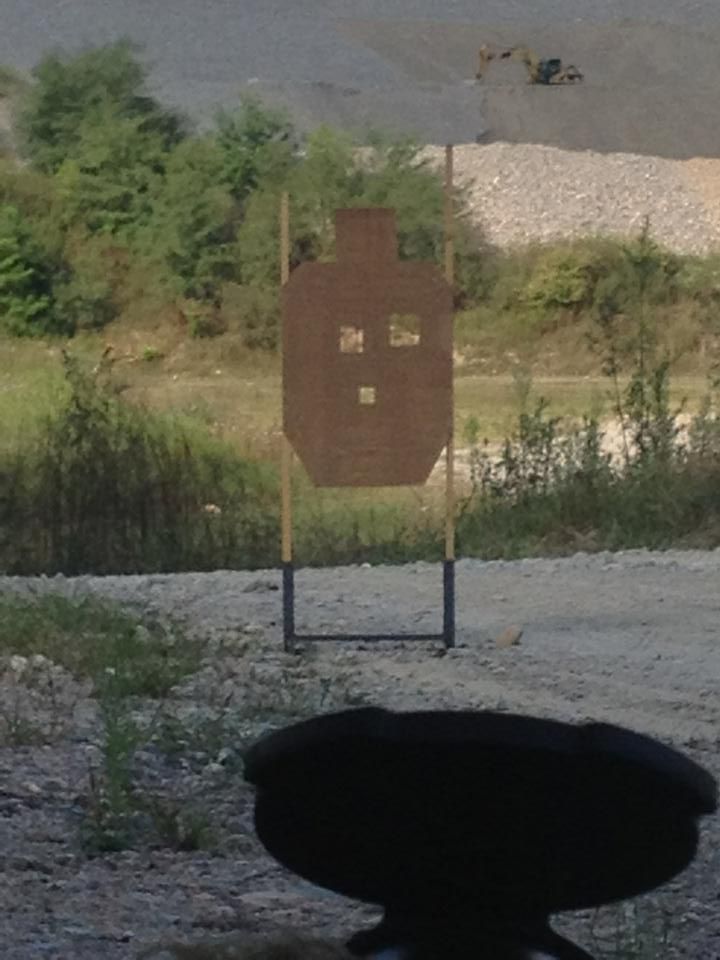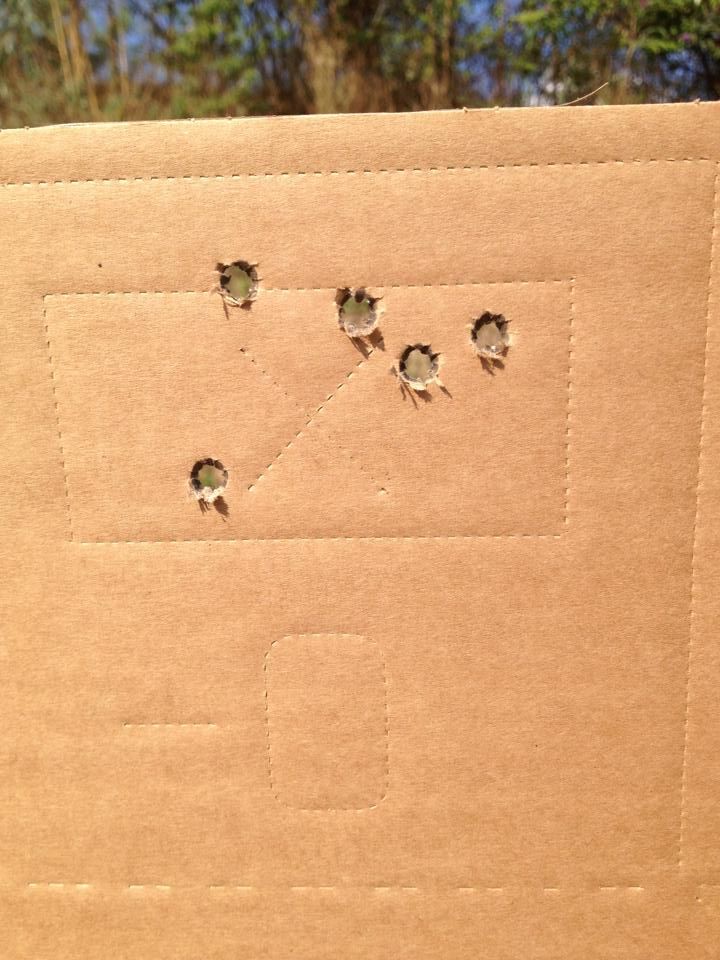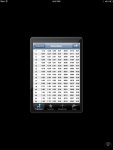Nice shots there one shot ST. For those who are curious, this information can be found in the owners manual of FFS which can be found here, starting on page 82. Anyone with $500 to spend can buy this software with this feature on it. No voodoo involved, no security clearance needed, no secret handshakes.

If you've used any ballistic software or an App with a trajectory page/graph on it you will soon realize you already have this information available to you.
http://www.lextalus.com/pdf/FFS Manual 4.8 - V.pdf
A video of this function can be found here:
23. Tools - LOS Metrics - LTFields's library
This is not all of it and some of the graphics are not present that are in the manual linked above but here is something to get you started:
LOS Metrics
The purpose of this work area is to enable a user to shoot through a small opening at a target a substantial distance beyond. The difficulty is that as the bullet leaves the muzzle it is well below the line of sight (LOS) of the shooter who is looking through the scope, through the opening and at the target many meters away. The bullet, however, has a path that moves upward and at some point will cross the LOS and continue in its arc to the target. Far down range, the bullet will again cross the LOS. A well placed shot means that this second intersection of the LOS is precisely at the vertical plane of the target. In that event, the bullet will strike the target exactly at the point of aim.
In order to shoot through an opening, the problem to be solved is to locate the path of the bullet with respect to the LOS in order to determine whether the bullet has room to pass through the opening at the plane where it is situated. This will, of course,depend directly upon the distance between the muzzle of the rifle and the down range location of the opening, its size, and the bullets trajectory with respect to the LOS of the shooter looking through the opening at the target.
Mode 1 - locating the first intersection with the LOS
W hen the bullet crosses the LOS initially, the bullet’s axis is nearly coincident with the LOS which would mean that the opening for this shot need not be much larger than the diameter of the bullet. This is a theoretical minimum since such a small opening would have extreme limitations on the field of view beyond its plane so as to render its use impractical at least. Nevertheless, knowing the distance from the muzzle at which the bullet crosses the LOS is valuable information since it guarantees that a shot can be taken through any opening of any practical size. Therefore, when the opening calculation form first opens, it automatically calculates and displays this distance based upon the currently loaded bullet, scope variables (scope zero and scope height) and atmospheric variables. (After this form is first opened, the state of the form will persist from use to use such that if the user was working with a particular mode, upon return the work in that mode can continue.)
Mode 2 - locating the bullet’s path with respect to the LOS
Tapping the second radio button enables a data entry box for the input of a distance between the muzzle and the opening. The resulting calculation is the path of the bullet at that distance. A negative value indicates that the bullet is below the LOS; a positive value, above. This value should tell the shooter whether the opening he is looking through has sufficient height to accommodate the bullet at the calculated distance above or below the LOS. The shooter can adjust his distance from the opening until the bullet is sufficiently close to the
LOS to allow it to pass through the opening without interference. M oving toward the opening will cause the bullet to move downward from its current location; moving further back will cause the bullet to move upward.
An interesting application of these concepts is the problem of shooting through a chain linked fence. The openings in the typical chain linked fence is just slightly under 2 inches square. Adding a reasonable buffer and the actual area to shoot through is more like 1.5 inches square. For example, assume a target at 250 yards and a chain- linked fence at 175 yards. For a typical .308 W in. cartridge, at 175 yards the bullet would be 2.78 inches above the line of sight given a 250 yard target. C aveat: For a variety of reasons, the program does not deal with cross-wind vertical deflection, Coriolis, or Eotvos effects on the loophole page. Therefore, when the opening is at range, be aware that there may be a small vertical and horizontal deflections that may have to be accounted for. Note windage value at opening. This assumes ambient wind effects from muzzle; this value may have to be modified mentally to the extent that some part of the
distance is shielded from the wind.
Tapping the units drop-down menu and choosing
M ils gives a value of 0.44 M ils above the LOS. The shooter would therefore make certain that reticle point at 0.44 M il would be centered in one of the link openings at the time the rifle is fired. Presumably the bullet would encounter the fence at the opening, travel through and on to the target.
Mode 3 - m inim um bracketed reticle values
Pressing the third button enables a data window to input the height of a particular opening and a second data window to input the distance between the muzzle and the opening. The resulting calculation tells the shooter the minimum reticle values to hold off the bottom and top of the opening in order to avoid having the bullet hit the opening structure. The portion of the reticle that is between these two values
must be kept clear of opening’s boundaries since allowing the boundary to encroach into this area risks having the bullet impact the opening’s structure. The values, given in either mils or M OA, are calculated to give a buffer of one caliber from the bottom and top of the opening. Of course, actually seeing the top and bottom may be a problem since the shooter may be too close for the scope to allow the opening itself to come into sharp focus, so these boundaries may be blurred. Nevertheless, the calculation will help the shooter be able to see, even if somewhat imprecisely, whether he is holding too high or too low such that he risks striking the structure. As long as the edges of the opening are outside of the bracketed area, his bullet should be able to travel through the opening without being compromised.
The user will note from the above example that the opening itself may be indicated in inches, centimeters, M ils or M OA units. These last two are impractical for specifying an
opening’s size but may be helpful in understanding the size of the opening in terms of reticle and where, using only the reticle, it would be safe to engage a target with assurance that the bullet will pass through. For example, the image shows the reticle brackets for a typical .308 W inchester cartridge, a 100 yard zero and a scope height of
1.5 inches. Here an opening of 10 inches has been specified with a distance from muzzle to opening of 7 yards. The bracketed area for the scope is calculated at 1.9 to
1.2 M ils which means that neither the bottom or top edges of the opening should encroach those limits in the scope. (Note that upper bracket is actually a buffer equal to one caliber at this distance. W hile the reticle could conceivably be placed right up against the top edge of the opening without a problem, the program was created using the opening height less a distance equal to two calibers so that there could be a one caliber buffer both top and bottom.)
The bracketed “No-Go” area is shown in red in the left graphic. This is the area which encom passes the possible bullet paths through the opening at the current distance. As the shooter moves down in the opening looking at targets near the bottom of the loophole, the bottom edge of the opening will be coming up into the scope. The bottom edge must not encroach into the red area. If it does, the bullet will almost assuredly strike the bottom of the opening. The same is true for the top of the opening and keeping it out of the red area. If the top of the opening touches or invades the red area, the shooter risks placing the bullet at or above the top edge of the opening. The bottom line is this: Keep the bracketed area clear and the bullet will move through the opening on to the target.
The graphic immediately left shows the same information as shown above except that the units have been changed to M ils. This gives a perspective to the shooter that the window opening at this distance is 39.7 M ils in height; the bracketed values are simply telling the shooter that he must stay away from the bottom and top 1.9 and 1.2 M ils
respectively of the opening. Note that this number represents the included angle formed by the muzzle at the vertex of the two lines extending from the muzzle to the top and bottom of the opening. As the shooter moves closer to the opening, this included angle increases dramatically. At some
point, the values given for both the opening size and the reticle brackets become unusable. For instance, if the distance to the opening was only 5 feet, the included angle would be quite large and the calculation would produce a result that would be meaningless on a practical basis, as shown to the right. The 10 inch opening has become 166.7
M ils in height and the bracketed values have become 20.9and 5.1 M ils. Because most scopes do not have reticles that subtend 21 M ils, knowing that the minimum distance the shooter must keep from the bottom of the opening is 21 M ils is not information that can be readily used.
However, it is possible to figure out where the bullet is with respect to the LOS at a distance of 5 feet by using M ode 2; the solution is shown at the left. At a distance of 5 feet from an opening, it can be seen that the bullet is 1.26 inches below the LOS at the opening itself. W hat can be done is for the shooter to look beyond the opening and at the field of view where he can choose a landmark that optically appears to be 1.3 inches above the bottom of the opening. W hen viewing the field of view through his scope, he will know immediately when he is in danger of encroaching upon the bracketed area when the intersection of the reticle elements are at or below this landmark. At that point, the bullet path is now within 1.3 inches of the bottom of the opening and the bullet will potentially strike the structure surrounding the opening. The shooter holds fire and waits for a target that is located at a point above the landmark.














